Sporting
Crash Course
Far from the TV cameras and multinational corporate sponsors, a North Carolina writer finds racing’s mud-splattered heart amid spray paint, smashups, and retooled junkers on a dirt track in the middle of a soybean field

Photo: Nathaniel Welch
Cars careen around a mud pit at Haw Hill Raceway during the Wilmington Crash Derby.
Standing near me is a large man in a dirty T-shirt. He’s holding a sledgehammer while eyeing the front end of a small automobile. He’s about to knock the hell out of a piece of wrecked fender that’s interfering with a front tire.
I’m in the pit area at Haw Hill Raceway in Winnabow, North Carolina, about thirty minutes out in the country from Wilmington. Last spring, thirty-two cars participated in Haw Hill’s first Wilmington Crash Derby, an event advertised as “a backwoods semiannual demolition/ endurance race held by Wilmington towing companies and automotive repair shops.”
On this beautiful fall Saturday afternoon, sixty cars are entered, and in heats of twenty cars each, they will race around an old-fashioned oval dirt racetrack. In the middle of the track is a large mud pit covered in very shallow water. I hope it’s shallow—I imagine hanging upside down in a race car with water up to my neck.
Cars roar around the track, not avoiding—in fact, welcoming—collisions. Even if you don’t know the rules, you can probably figure out that some cars will last, some won’t, and the last one moving will be the winner.
Each car puts up $100, and the winner gets $5,000.
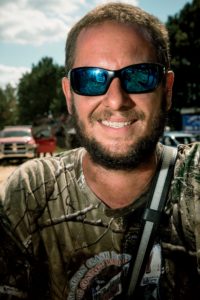
Photo: Nathaniel Welch
Full Contact Racing Association founder Ryan Roane.
As Ryan Roane—the owner of Ryan’s Automotive and the brains and brawn behind this event—tells me, “This race is all the fun things about nascar without all the stuff you hate: the stupid rules, the cautions, that the cars are exactly alike, that a driver is fifty and his wife is twenty and he’s talking about what a family thing it is.”
The first heat ended about ten minutes ago. I and the gentleman with the sledgehammer and a lot of other people, men and women, boys and girls, are either working on a car or meandering about in the pit area, about half the size of a football field and situated at the north end of the track. Around me are parked RVs, flatbed trailers, lawn chairs, grills, coolers, pickup trucks, and lots of small kind-of-wrecked cars—many spray-painted in a folk–art deco style.
People bend over car engines, squat beside tires, come running with freshly modified radiator hoses. I see somebody stuffing a cork into the open end of a hose that’s attached to a running engine as somebody else tightens a clamp to hold the cork in place. I move out of the potential bullet-cork trajectory.
The sanctioning agency for this nontraditional race is the Full Contact Racing Association, and Ryan runs the show. He comes across not unlike the race he’s created: unadorned, straight at you, centered on fun and entertainment.
If you’re watching from the stands at Haw Hill, or sitting in a driver’s seat, or prowling the pit area as I am—there’s something satisfyingly primal about this event. It brings together families, rural culture, noise, laughs, adventure, tension, and suspense…some of the stuff I’ve been trying to put into fiction for about forty years. But this scene is neither abstract nor imagined.
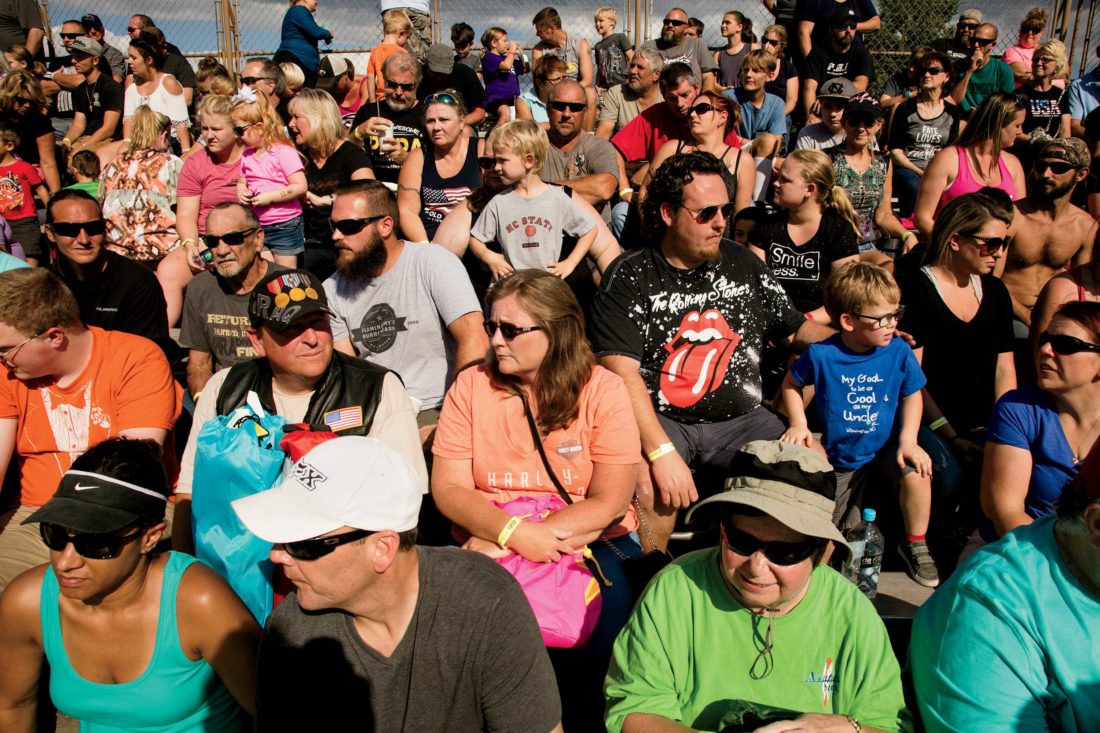
Photo: Nathaniel Welch
Spectators fill the stands
And the actual place, the dirt track, the stands, puts me back at the Orange Speedway near where I grew up, and where I attended races in the fifties and sixties. A long-gone dirt track in Hillsborough, North Carolina, it opened as the Occoneechee Speedway in 1948 and closed in 1968. Bootleggers used to race there and on other similar tracks throughout the South. Today that overgrown Orange Speedway track and remnants of the grandstand are a site on the National Register of Historic Places, complete with hiking trails.
To find an event like today’s race, like something I loved as a kid, is a lovely (and cheap) thrill.
A quarter mile away from Haw Hill, on a blacktop rural road beside the soybean field that this race track is in the middle of, passenger cars holding hopeful spectators wait bumper to bumper to pay the twelve-dollar-per-head entry fee.
Near me here in the pit area, a race car has a rubber chicken affixed to the end of what looks like a radio aerial. Another wears a massive wedding veil. A long green car with green wooden fins along the top has SWAMP THANG written in large letters along each side.
Let me back up.
Last summer, I came upon a friend, John Howland, working on a beat-up 2001 Pontiac Grand Am inside the auto repair shop that I most often frequent, Advanced Automotive of Wilmington. John and another friend, Michael Daniel, co-own the place. The repair shop is always full of cars, trucks, and large RVs.

Photo: Nathaniel Welch
Hands-on work.
I noticed, sitting on the trunk of the Grand Am, a can of Raid. John explained that an ant colony had taken up in the trunk since the last race.
“You raced this car?” I asked him.
“Oh yes. And I’m getting it ready for the next race.”
John likes to, in his words, “create, modify, and fabricate.”
Both he and Michael used to be heavy into drag racing. Photos of the two of them and drag racers are posted here and there around the shop. But drag racing is expensive and they decided to back away from that sport. And now a less expensive form of racing has come to Wilmington. Before the first derby last spring, Ryan begged John and Michael to get into the fray of Full Contact Racing. They finally relented and are now two members of a four-man team that’s in today’s race. The other two: Caleb Greene, John’s stepson, who will drive the Grand Am, and Will Gibson, a mechanic at Advanced Automotive, driving a feisty 2004 Ford Focus.
Think of it this way: bumper cars for adults driving real cars… with an occasional engine fire or rolled vehicle, continuous smashups, or somebody stuck in the mud pit. Similar to a demolition derby, but less blunt, less boring, more sophisticated, more fun.
The skill here comes from an intricate combination of offense and defense. Push another car into a dirt bank, or into the mud pit, or ram it—just somehow render it unmovable while not becoming that way yourself. Sometimes speed is good, sometimes it’s not. But don’t drive scared and hope for longevity. At the prerace drivers’ meeting, Ryan announces: “If you sandbag, if you try to play it safe to survive and don’t hit, you will be yanked out and disqualified. We are here to entertain all these people in the stands, and they want to see an aggressive race.”
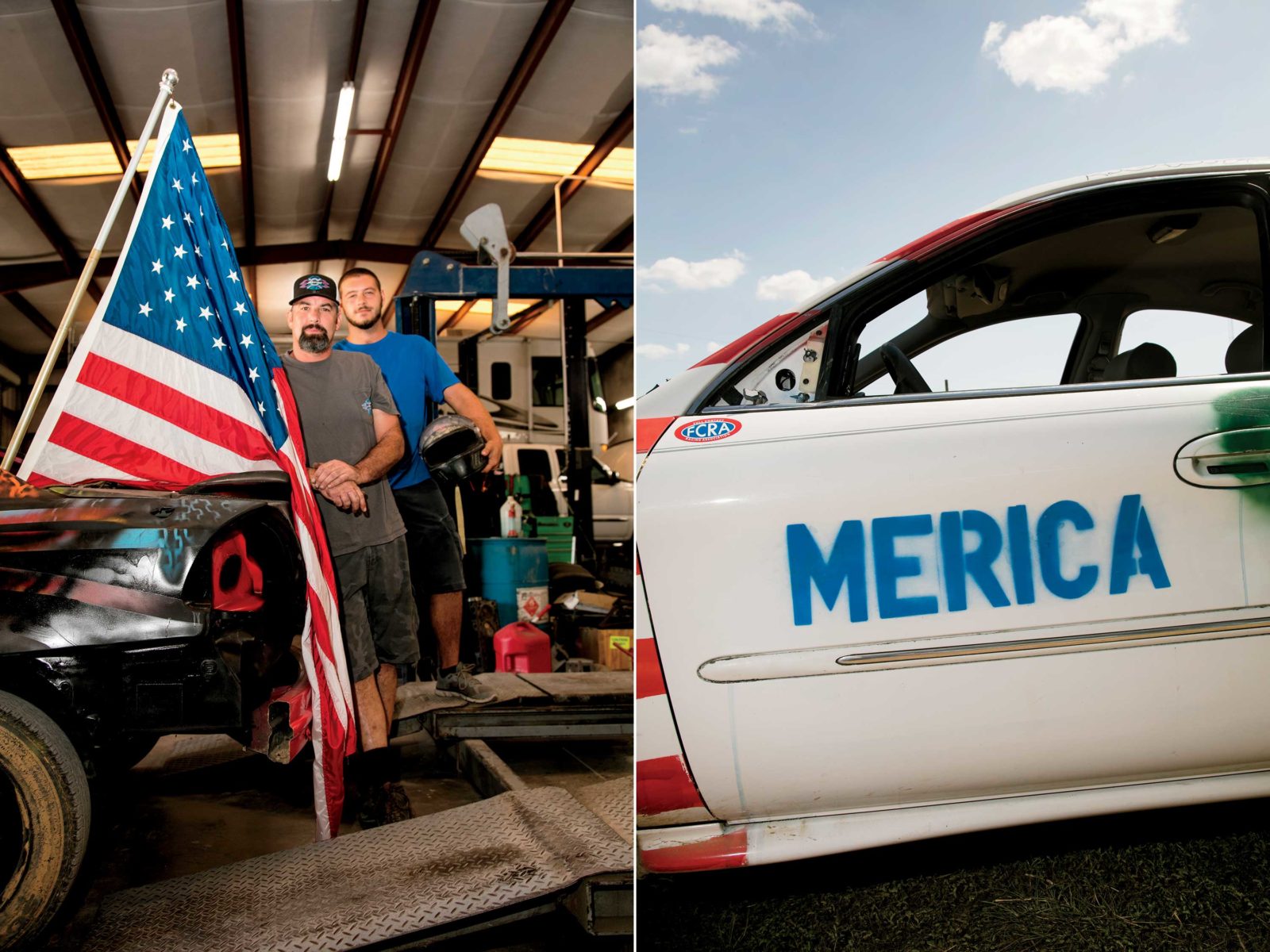
Photo: Nathaniel Welch
From left: John Howland (front) and Caleb Greene of the Advanced Automotive team; a car ready to roll.
Some rules:
1. Fifteen-minute heats.
2. To be a driver, you must be eighteen and able to see.
3. You can’t intentionally run into the driver’s door. But you may ram another car anyplace else.
4. All windshields and other glass must be removed from the car.
5. Steel bars or wires may be attached in place of a windshield to prevent another car from entering your car.
6. Only four- or six-cylinder cars are allowed (probably a fairly useless, previously wrecked or run-down one, perhaps found behind a wrecker service business, an auto repair business, or a transmission business).
7. No spare parts except tires and wheels. Duct tape and zip ties are fine.
8. An X will be spray-painted on the roof of each stalled car at the end of a heat. Two Xs and you’re disqualified.
9. Drivers must remain in their car after it becomes immobile until the heat is over—unless your head is underwater or your car is on fire. In those cases you may exit the car.
10. If your car is on fire or your head is underwater or the race needs to be stopped for another reason, then the announcer will announce on the loudspeaker system: “Stop, stop, stop, stop, stop!” And he will keep saying this until everybody stops.
11. Nothing can be attached to a car that will intentionally damage another car—like spikes or, say, a grenade-tipped spear.
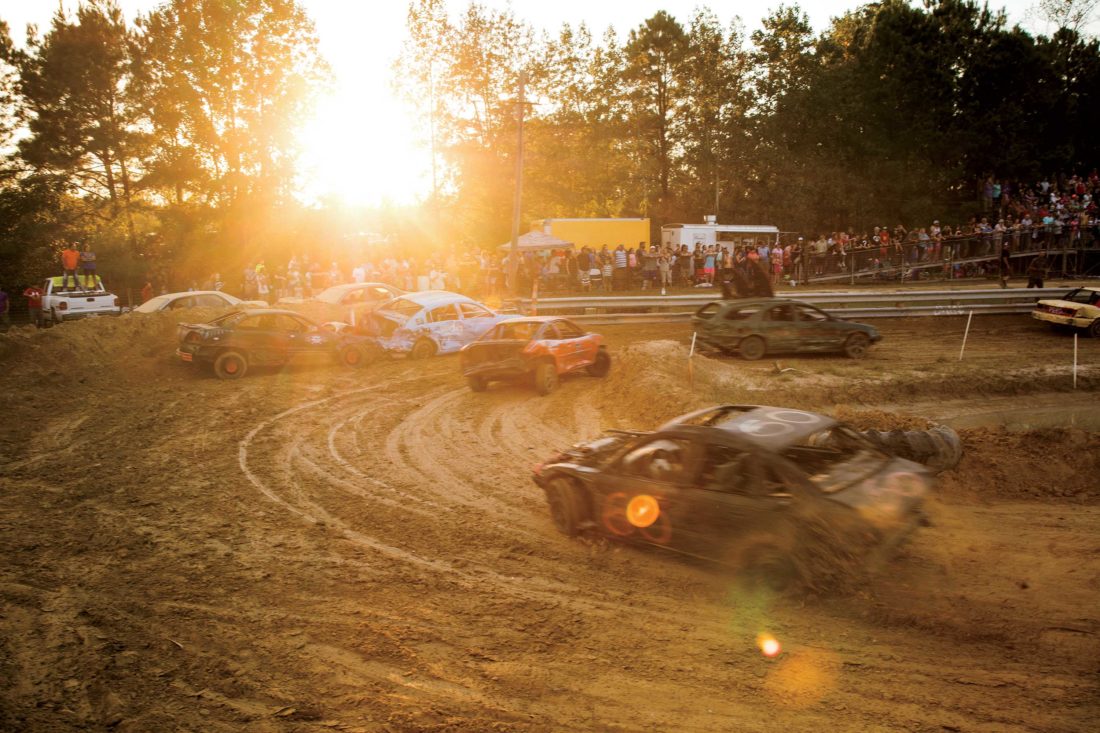
Photo: Nathaniel Welch
Surviving cars continue to race as the sun goes down.
It’s the third heat. Whoa…white smoke is rising from the engine of a stalled car on the track. Over the loudspeaker: “Stop, stop, stop, stop-stop-stop-stop!” Several firefighters, one with an extinguisher, move across the track toward the car. The driver is waiting inside the car. What? He’s just going to sit in there? Then I’m thinking: Aha, he thinks he might get going again. The firefighters can’t open the hood at first, then it pops open. A firefighter sprays white foam onto the engine. White smoke billows. Suddenly orange flames appear. The driver hurriedly exits the car and raises his hands over his head. The crowd roars. He walks away from his car, looking over his shoulder. I can feel his deep desire to be back in the race. The fire is now out. There’s a sudden loud pop nearby, and from the hoodless engine of another car a geyser of scalding water shoots at least thirty feet into the air. The crowd roars. The firefighters exit the field. The announcer orders: “Go, go, go.” The cars that can still move, move out.
Some suggestions:
1. Remove the radiator and bolt it against the rear seat back and install appropriate tubes and/or pipes and/or hoses to run coolant to the engine and then back to the radiator.
2. Place your battery on the front floorboard.
3. Move your exhaust pipe from the rear—otherwise it will get pinched off and the car will shut down. Run it straight up out of the engine.
4. Try to hit other cars’ front wheels in order to disable steering.
5. Wear a helmet.
We are at the end of the fifth heat. Soon the dusty track will be watered down enough for some slipping and sliding and other mud fun. Nobody seems tired. Eliminated drivers are rooting for friends. This has been going on for hours. The stands are still packed to overflowing. Swamp Thang is rampaging and has become a crowd favorite. About half the cars are out, half still in.
I meet and talk to Finn Ramsey, who’s here with several drivers and race cars (including Swamp Thang). His extended family is on-site, along with an RV complete with awning and comfortable seating area. His son, Ryan Ramsey, driving Swamp Thang, is working on his car and can’t seem to remove a big smile from his face. I count eleven other men working on, under, and around his car.
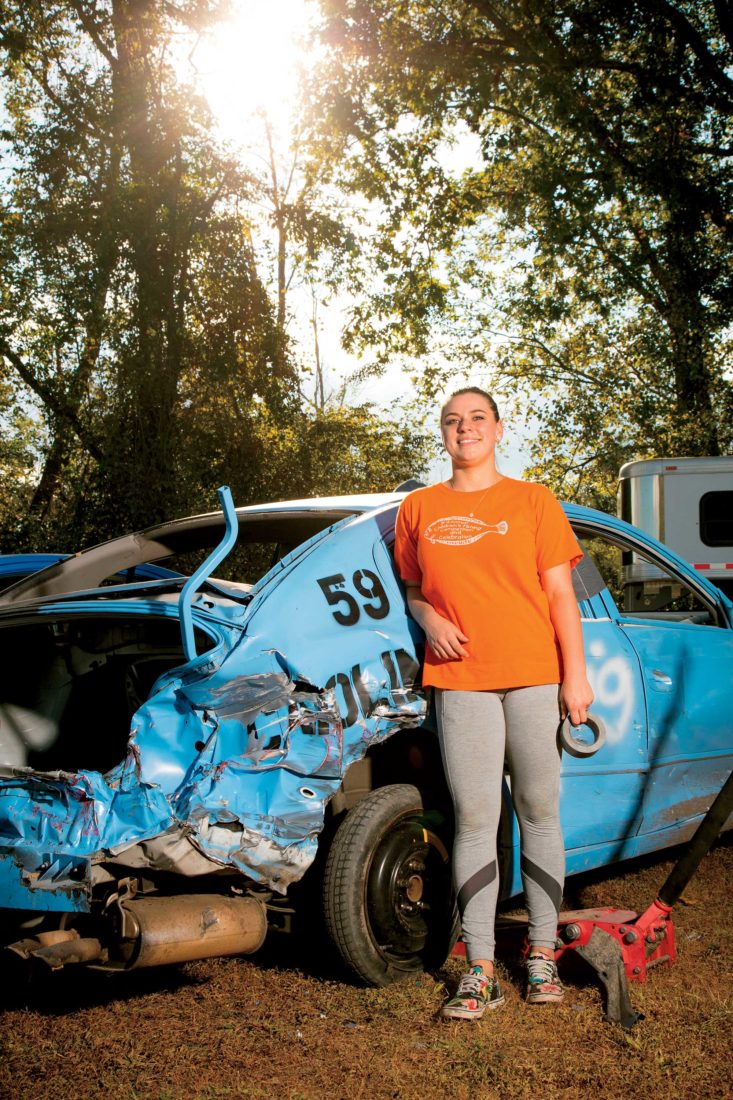
Photo: Nathaniel Welch
Driver Brianna Schierenbeck.
Also with the Ramseys is Brianna Schierenbeck, twenty-one years old. A few years back Brianna was a cheerleader at Laney High School. Recently, she was going to scrap her car, but her stepdad, an employee of Finn’s, suggested she race it.
I meet Kenny Gilchrist, owner of Greenfield Transmission Services. He’s fielding four cars and driving one of them. Family and coworkers are along. “You still in?” I ask him.
“Oh yeah,” he says. “Two cars in, two out. Man, this is fun.”
I don’t know Kenny’s age, but at this moment he seems about twenty years younger.
I find my friends, the Advanced Automotive team, John and Michael, with drivers Caleb and Will. Will’s Ford is out for good due to a broken CV (constant velocity) axle. It broke early in the third heat, and he had to sit facing oncoming, spray-painted, collision-seeking machines for almost fifteen minutes.
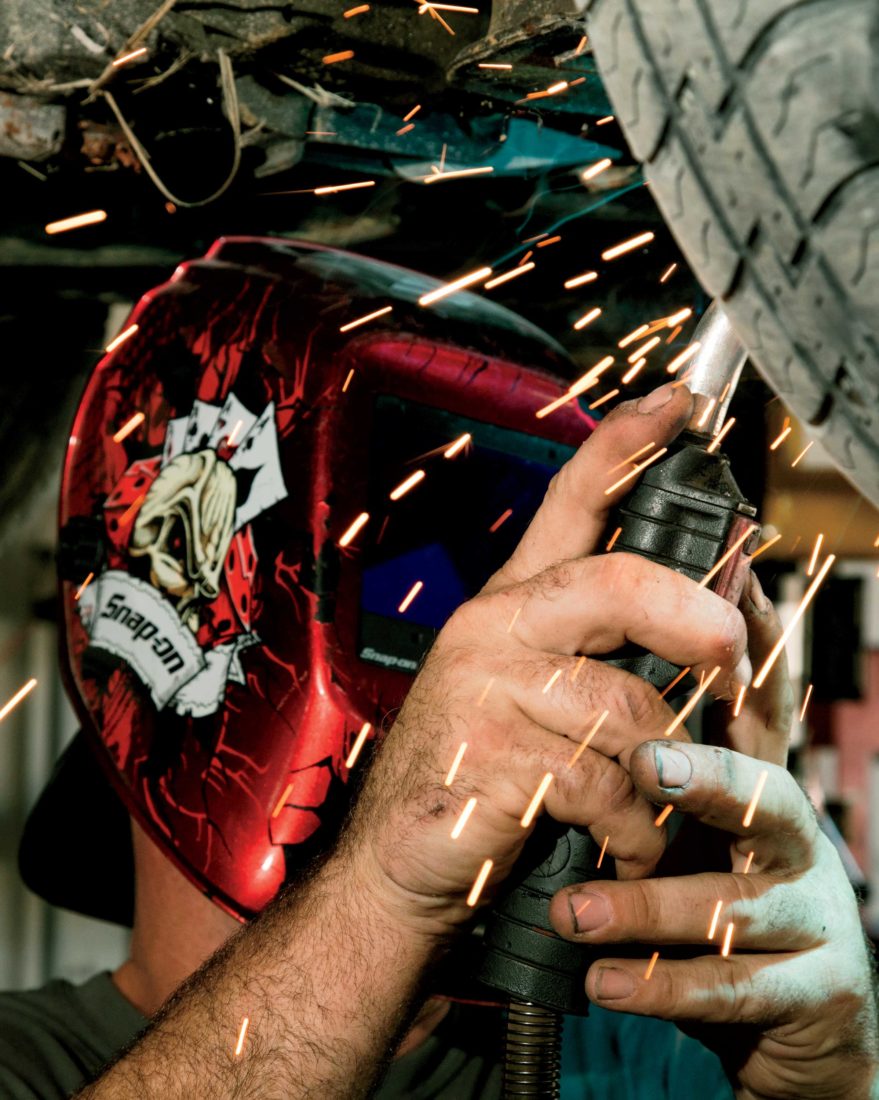
Photo: Nathaniel Welch
Prepping for the race at the Advanced Automotive shop.
The Grand Am has blown a coolant hose, but the hose has been repaired. The car is good to go again. There’s hope for the home team.
“On that first race last spring,” Ryan tells me, “I had to fill up the bleachers, so I got the Brunswick County sheriff to race—gave him a car and suggested that if he won, he could give his winnings to charity. He’s back this time along with the sheriff of New Hanover County.
“I went to local businesses. Not chains like Hooters, but locals like P.T.’s Grille. Showed them pictures. ‘You guys want to sponsor?’ I said. ‘It’s only a couple hundred dollars. I’ll decorate, provide the car, advertise for you on Facebook.’ No one said no. I modified fourteen cars. All I had to do then was put asses in the seats.”
“Where’d you get the asses?”
“People walking in my shop was one way. One guy, he was all energy. He jumped at the chance. I said, ‘Man, give me a hundred bucks, you need to be in this race,’ and he pulled out a hundred dollars.”
Ryan is clearly in control of the operation, and his mission is wrapped in common sense, a clear-eyed vision, and steady enthusiasm. He knows racing and loves it, but he also knows how easy it is to sink money into, only to end up sinking in more. “For nascar and drag racing and bracket racing and all that, the motto is: The way to make a small fortune in racing is to start with a big fortune,” he says, with characteristic deadpan. “My racing here is for people without big fortunes, and it won’t ruin you.”
The Grand Am is knocked out just before the next-to-last heat. Same for Brianna’s car. For the very last heat, all remaining moving cars, twenty-four of them, will race for as long as necessary until only one can move. The race that started at 3:00 p.m. ends at about 9:15. A little Honda, driven by “Red,” is the last auto moving. Red takes home five grand cash and a trophy.
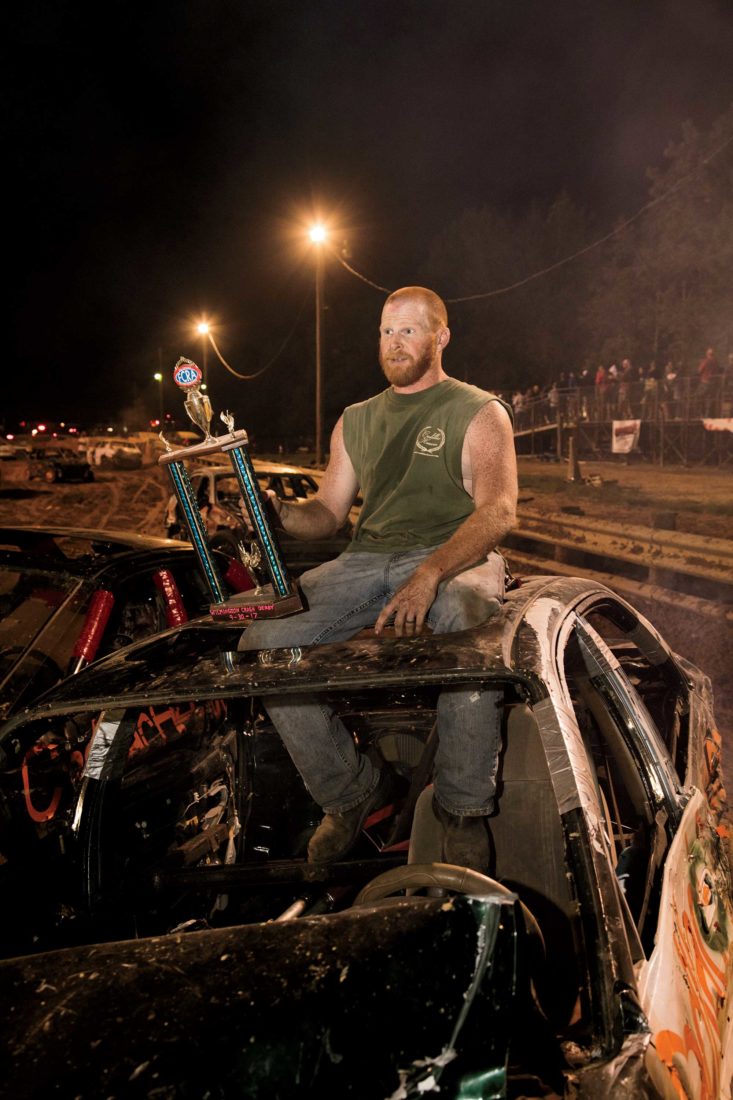
Photo: Nathaniel Welch
Taking home the trophy.
In less than an hour, all is quiet. I think about a late night after a baseball game, the field and empty stands leaving memories. Bumpers, fender parts, and other car pieces rest here and there. The dirt track cools as the energy of the race drifts up into the night. All is quiet…and a little sad. As they say, it’s not the destination, but the journey that counts.
Another race is coming to Winnabow in April. If you come, get here early, or else you may be left in a long line out on the blacktop. On the other hand, you may not have to travel far if a Full Contact race comes to a dirt track near you. Maybe you can find an adventure-seeking mechanic and a little old car that wants a last hurrah. Spray-paint it. Drive that sucker. Feel the fun.







